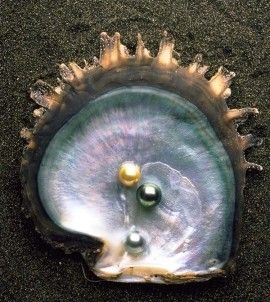The pearls are classified. This classification is essential for the pearl because it determines its value and also its potential use. The classification is determined by different criteria such as the diameter of the pearl, its luster or its color. Although there is no international classification, there are general and universally recognized criteria. However, unlike diamonds, the classification of pearls is done according to the nomenclature of the country of production.
Here are the main criteria for evaluating pearls and their notes. This classification we present to you corresponds to that of Tahitian pearls. It should not be applied to other pearls such as those in Japan because although using the same classification criteria globally the different classifications do not assign the same importance, the same coefficient to each criterion and therefore does not give the same score to each pearl. So the ranking is different.
Our article on pendants.
The five different criteria used for the classification of Tahitian pearls are:
-
For starters we can deal with the shape of the beads. This shape is very important because it gives an overview of the pearl without it having even been studied or admired. Many forms are recorded in the classification registers for Tahitian pearls. A few shades near these titles representing shapes are also used for the majority of other pearls around the world, cultured pearls at least. Two majority forms can be distinguished in Tahitian pearls. Each of these two forms also has a parallel form. Finally, a special feature can be added to distinguish the shapes.
-
Several bead sizes exist. The larger the size, the higher the value of the bead. The average diameter of Tahitian pearls is between 8 and 15mm. Above 21 cm the beads are said to be exceptional in their size.
-
The surface of the pearl corresponds to the state of the mother-of-pearl layer of the visible pearl. There may be some irregularities on the surface of the beads. Thus, the less irregularities there will be, the more expensive the pearl will be. A very precise classification calculating and measuring each imperfection exists, thus allowing to determine what the true value of the pearl is according to the state of its surface.
Our article, about earrings. Our article on the thickness of the nacre.
-
The luster of pearls is the fifth criterion taken into account in the classification of Tahitian pearls. The chandelier corresponds to the brilliance of the beads. Brilliance is in a way the reflection that the pearl can give. Pearls with a very high shine are called exceptional. On the contrary, the one with the least brilliance are said to be poor. Since Tahitian pearls are not treated the shine of the pearl really corresponds to its natural luster and not to the effects of some chemical.
-
The last element influencing the price of a pearl and therefore its value and classification is the color of that pearl. Different pearl colors exist however the color most present in Tahitian pearls is black. Tahitian pearls are the only pearls to be black. For Tahitian pearls other colors shades of green will often be noticed.
Our unpublished article on the color of pearls

French Polynesian cultured pearls
The dream is also what Tahiti evokes, this beautiful island so far from the rest of the world but especially from our motherland France. The dream is also all the other wind islands of the Polynesian archipelago of the Society, which are all jewels of purity in an azure blue setting. It is in these enchanting places that the miracle is born, the pearls of Tahiti culture are known and recognized all over the world and the jewels that are made with are the greatest one in the world, used by ladies from all corners of the planet, movie stars, television, song, etc.
The pearl of Tahiti is probably as popular as the crystal clear beaches of this Pacific island. The great success of these cultured pearls is global, the jewels are the prophets. As in all commercial areas the value is measured according to quality and also depends on many factors that will come into play in setting the price of a tahiti pearl jewel.
Pearl of Tahiti: a miracle of the ocean?
A rare pearl from the aquatic environment found in Pacific oysters but not just any. Pinctada Margaritifera is the pearl oyster with which we will obtain black pearls from Tahiti, these are so coveted that scientific research is focused on genetic selection. It is following a secretion that the future birth of a pearl occurs. It should be noted that transplants are carried out by man's hand to obtain cultured pearls, however and despite everything this operation remains a miracle of nature.
Black pearl, grey pearl
Colors, diameter, reflections, sparkles, brilliance are all parameters that enhance a jewel in Tahiti pearl. Want to buy an original piece of jewellery? You can buy it on our store so you get the best value online. A black Tahitian pearl is more expensive than others because it is rarer, in French Polynesia it is then called poe rava. However there is no better place than our online shop to acquire black or grey pearl jewelry.
Production of a tahitian pearl
The pearl of Tahiti is a pearl of culture coming straight from French Polynesia. A pearl is a production of certain molluscs due to a reaction. When an irritating object enters a mollusk, it will react by producing around that object a layer of caCO3 calcium carbonate in the form of calcite especially for cultured pearls. This mixture of the object and the outer layer is called mother-of-pearl. Once entirely natural, this manufacturing process was developed by the Japanese as early as the 1970s by the cultivation of these mother-of-pearl pearls. Today many islands produce their own pearls, each of which has its own properties. French Polynesia is currently the world's largest producer of pearls.
Black Pearl of Tahiti
The most famous pearl of Tahitian pearls is the black pearl of Tahiti. It is this pearl that we will talk about in this article. It is produced by a black-beted oyster, the Margaritifera de Pinctada. This oyster is about 30 centimetres long and weighs about 5 kilograms. Because of its size, the oyster can produce pearls of great size and therefore of great value.
Once removed from the oyster, the black pearl of Tahiti is cleaned to remove the liquid from the oyster. The cleaning of several hours is the only modification made on the black pearl of Tahiti once it has been removed from the oyster. Once cleaned, the beads can be sorted and classified. Unlike diamonds and other gemstones, pearls do not have an international classification officially recognized by all states. However, 5 criteria often allow these high-value beads to be categorized.
Research associated with Tahitian pearl
Tahitian shop pearl, Tahitian pendant pearl, Tahitian pearl price, pearl of cheap tahiti, pearl of tahiti quality, pearl of tahiti man, pearls of tahiti, Tahitian pearls, classification of tahiti pearls.
